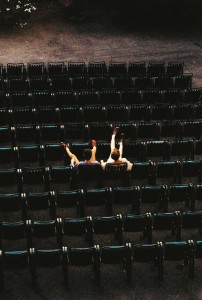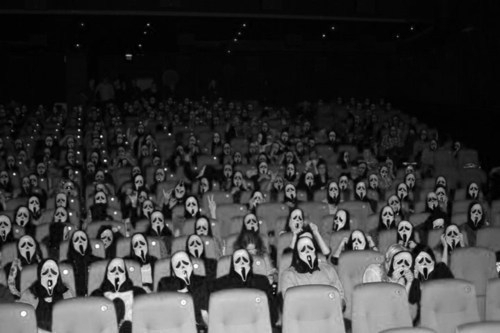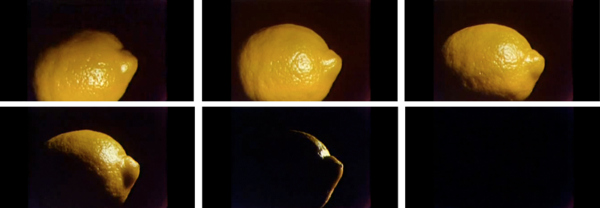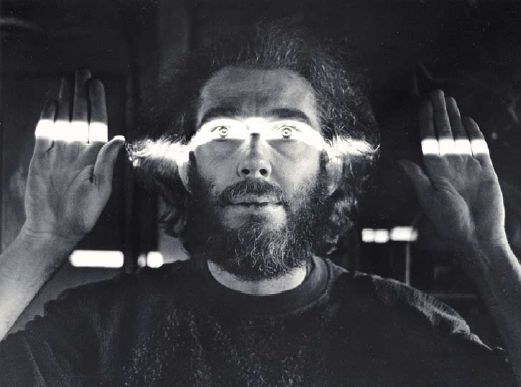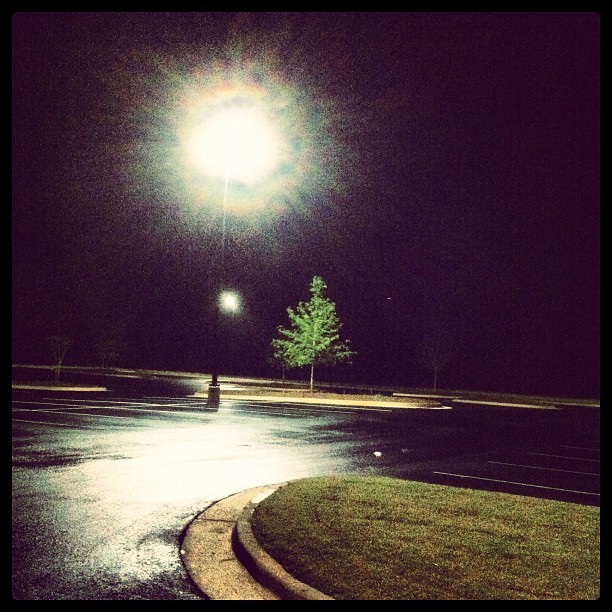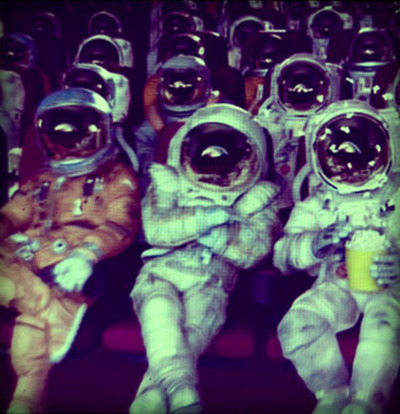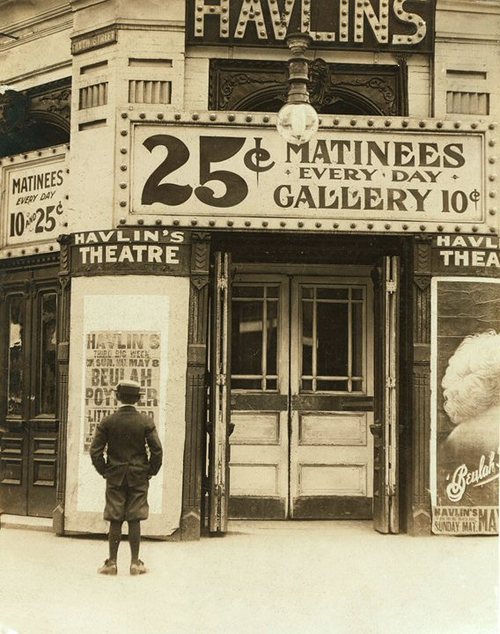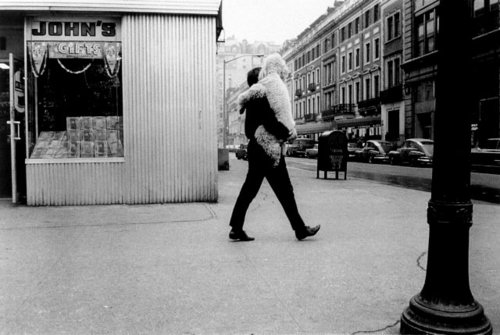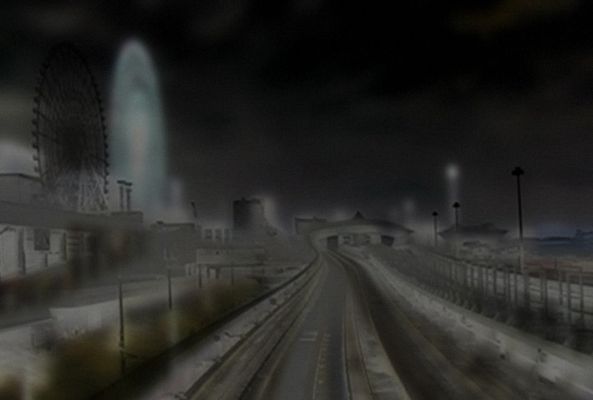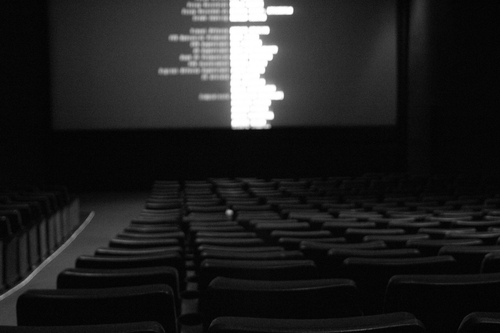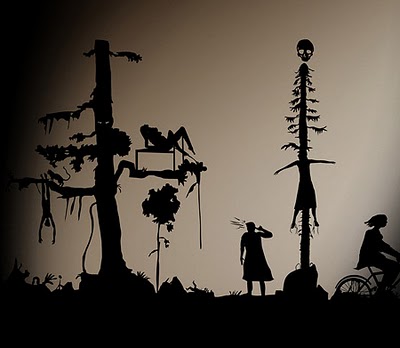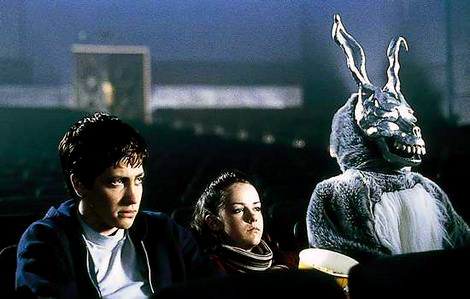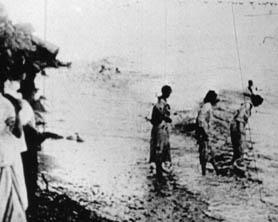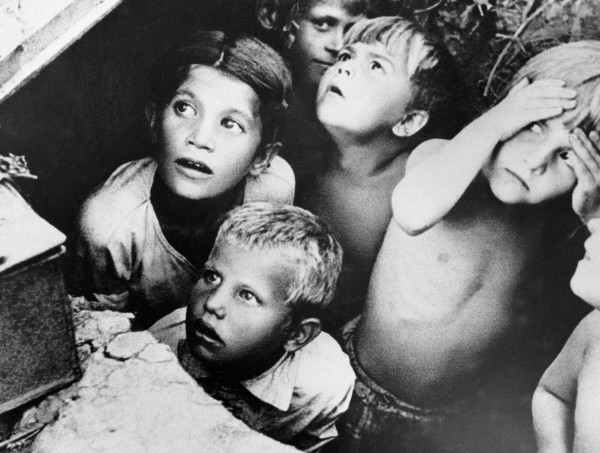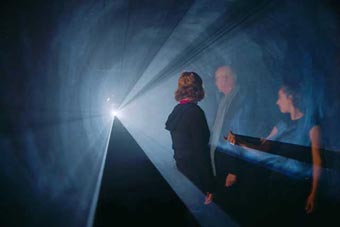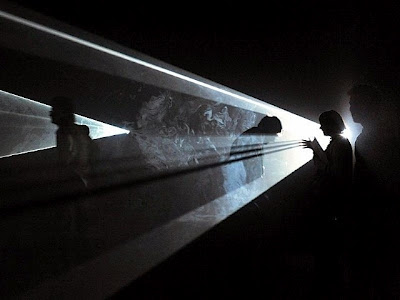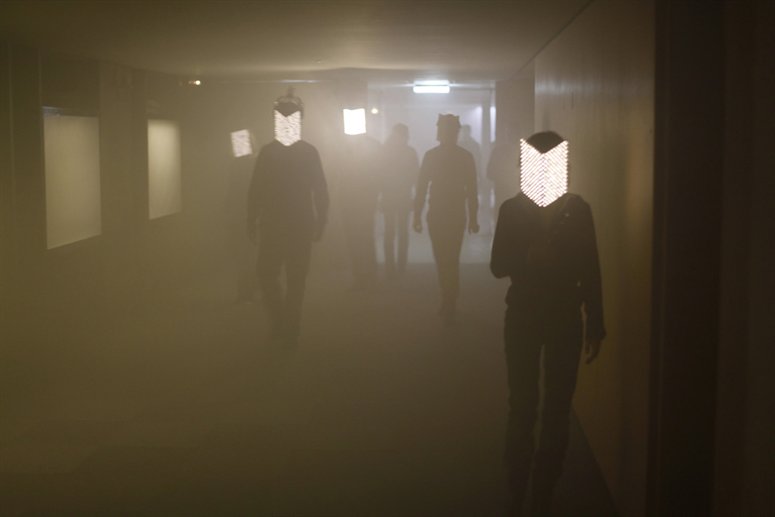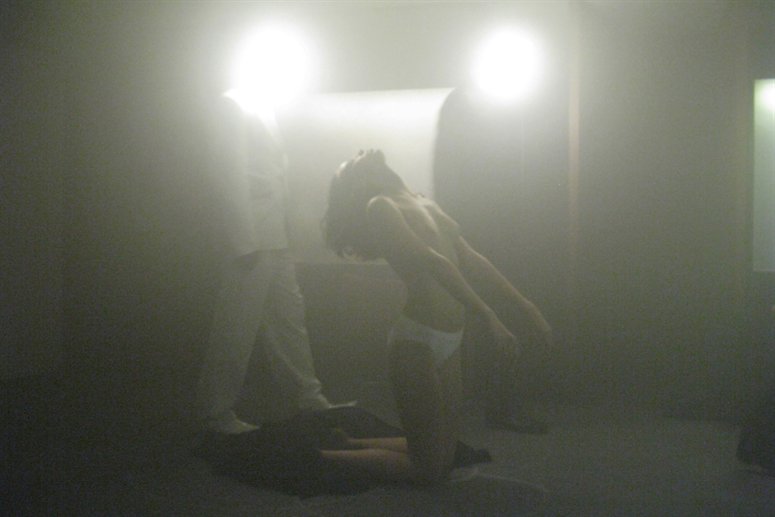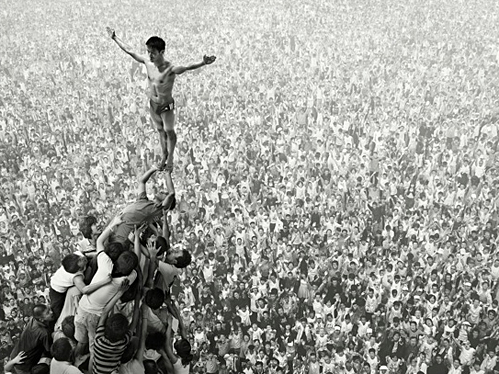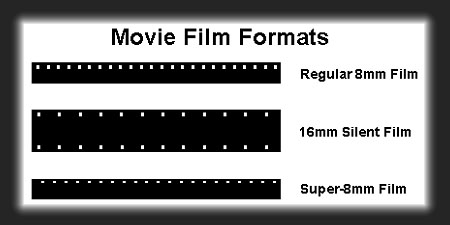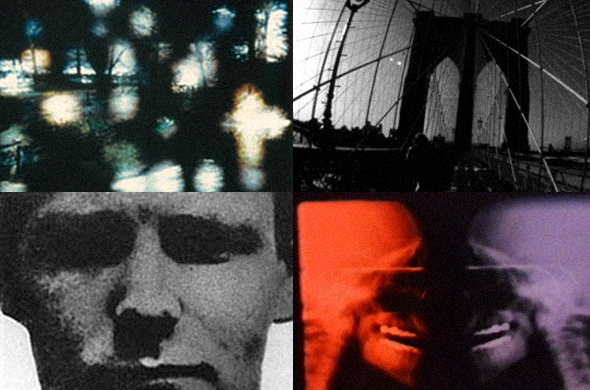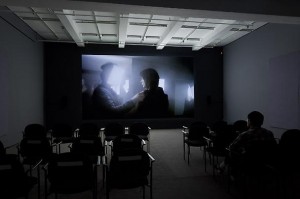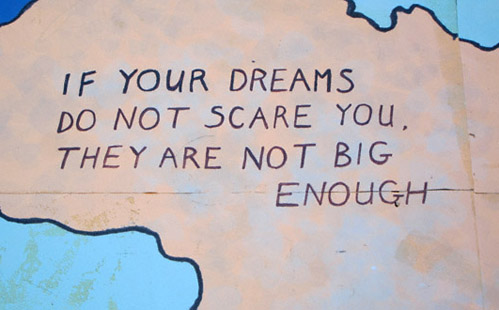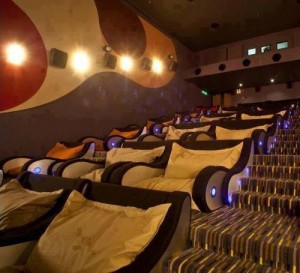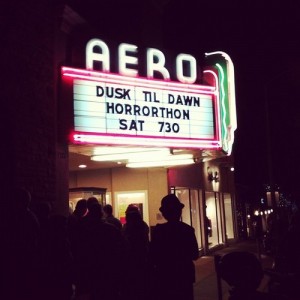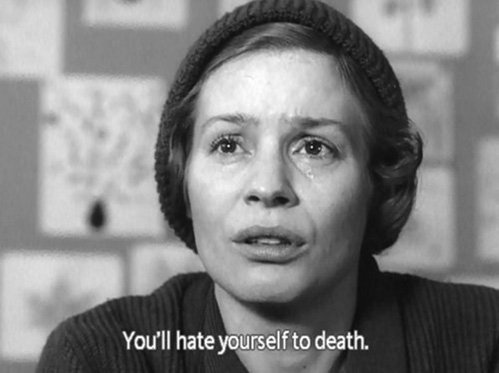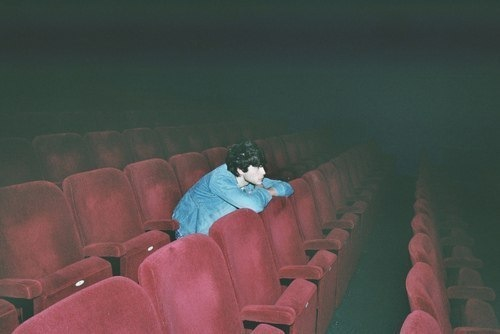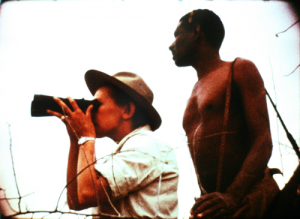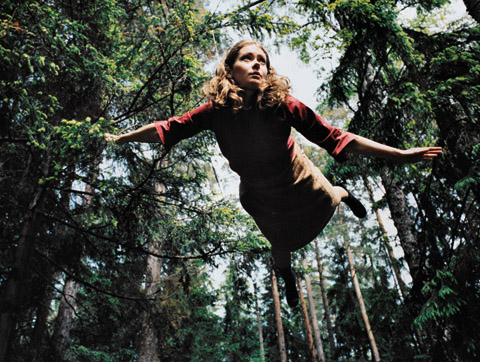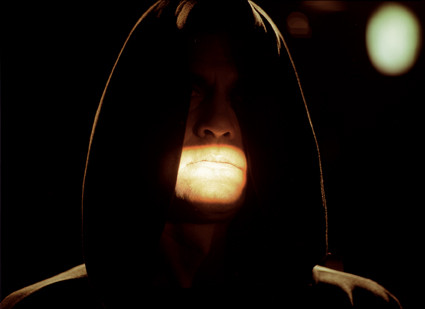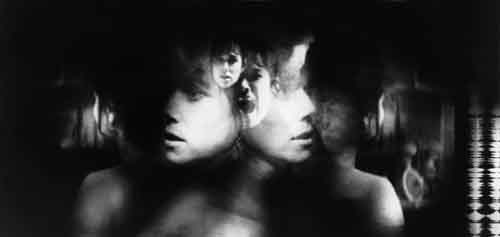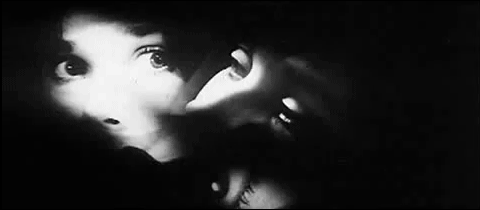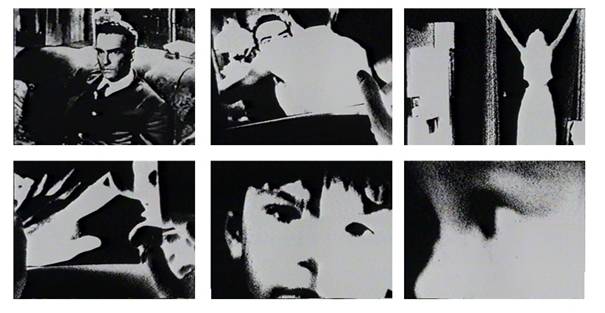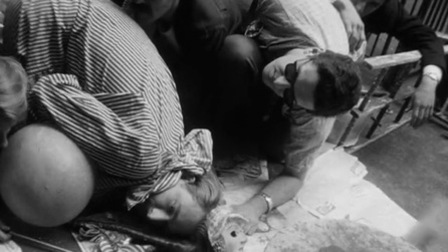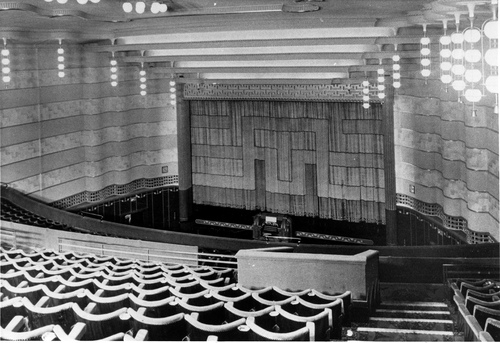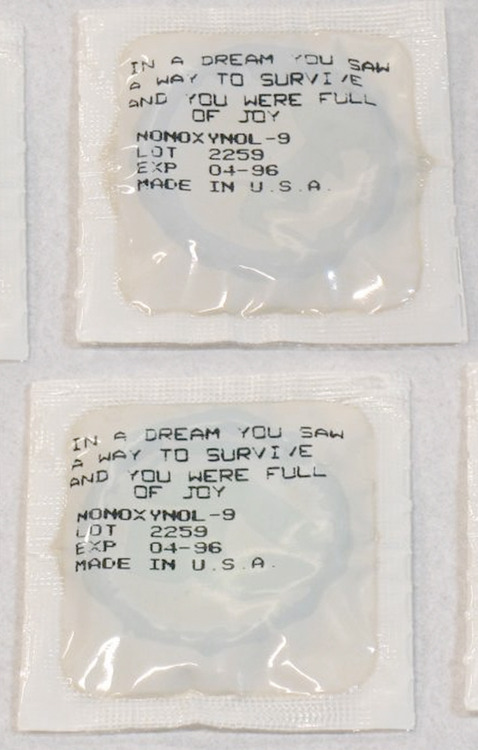Mike: The question of distribution pricks me at the moment, perhaps because my work is shown either to specialists who have already seen it all, or to the absolutely uninitiated, like the high schoolers in Guadalajara who were forced to endure their first ever documentary movie in a vast assembly room better suited to the speeches of bleeding virgins than my fragmented corpses. At least they had the company of their cell phones to warm them when the montage refused to settle into a reliable three act structure, unlike their daily conversations, their busy fingers tapping out the harmonies of major chord delights and narrative closures.
It seems to me that fringe media distribution has defaulted into two primary modes, in art galleries and in festivals. How many times did artists at the recent Rencontres Festival in your beloved city stand to announce that the movie we were about to see was “really” an installation, but was showing here as a “single channel” movie. Well, as a movie after all, shorn of ambient light and visitors shuffling between rooms and yes, the ringing of cell phones. Reluctantly, they seemed to announce, their work which seemed to my old fashioned receptors to be movies, had been returned to the movie theatre.
The reason that festivals do not bring me happiness is because they stink of the mall. There are too many pictures shown all at once, one after another, all howling for attention like the Bargain Prices Reduced No Offer Too Low signs which greet me in the covered bins of the no-frills shopping paradise. Is it only me? I find it hard to separate one illuminated hope from another, they all blend and jam and mix, after a single short program I am already confused, and then there is another and then another. And afterwards, perhaps it is the shallow company I seek in respite, but no one speaks about the movies, or only in the most cursory of terms. I liked it, I hated it, it was boring. Yes, surrounded by artists at the festival bar I am returned to the mall. I’ll take it, I love it, where’s the food court? I want it or I don’t. I must have it or I never want to see it again. And running through it all is the heady aroma of forgetting, which I embrace like the good North American that I am, and which I find amply demonstrated by every festival I have ever visited. What I am watching is less a procession of pictures and sounds, but the vapour trail of their disappearance, as they make their way across a crowded theatre, or a not-so-crowded theatre, or the shop window of the internet café that resides in the “festival neighborhood,” or the bar which dishes drinks next door to the festival headquarters. Yes, there are pictures playing everywhere, and just like in the mall the more I see the less that manages to stick to me. What’s your name again?
Each program runs only once, each sliver of light appears and then will never be shown in that city again. We’ve had it, we’ve had enough, it’s old news, soiled. Once its light virginity has been stripped away please cast it out into other cities, where it can recover its lost innocence before new eyes. Yet again (and again) the bride stripped bare, even.
But there is still the possibility that from this noise some moment of cinema might arrive. The physical conditions are impeccable after all, the light cast into a darkened chamber, with real speakers and a reclining cushioned perch to absorb it all. The festival seat offers its viewer an invisible visibility, invisible exactly because these pictures appear so fleetingly, there are no reruns, no time shifted channels, no way to see it later via home video or bit torrent happiness. They appear like a series of mirages, and then are returned to the basement shelves of their makers.
On the other side of the fence are the gallery artists. Some are already kings and queens, the subject of learned treatises and awards which have turned the heads of even the most judicious of collectors. Histories have been rewritten to note their prominence of place, the Bolex winders of the past decades have been relegated to a suitably dusty and forgotten recess, while in their place march the painters and sculptors who might once have held a camera and exposed a few frames, rolled a bit of tape between performances, these are now the benchmarks of a new art, marked and remarked in handsome periodicals and coffee table companions. History is always written by the winner, and anyone who is able to follow the money may quickly enough track the rise and reign of “important” artists who have left behind those who failed to make a market impression.
This work is released in “limited editions” (just like the limited editions of 16mm prints from a generation ago – who could afford to make more than a few prints? Only now at the moment of digital proliferation, dvd bootlegs may be had for nothing at all, while signed copies can fetch enough to keep landlords from the door) and parlayed to a coterie of collectors. The newly commodified beams of light appear, unlike their festival counterpart, “all the time.” If the gallery is open that can only mean that the movies are “running,” hard at work, busily staining a bit of back wall. The gallery installation offers the possibility to its viewers that it may be encountered in a time of their own choosing, and is willing to trade for this convenience a suite of bad projectors, dismal sound, ambient light, competing soundtracks and audience chatter. Oh, and mostly they are attended by party goers at openings where no one looks at the art all.
There is one experience with gallery installations that seems paradigmatic. It is a moment, no larger than that, but I imagine it narrates a summary of the field. My friend Jason is something of an audio visual masochist, so naturally enough developed an interest in the work of Hollis Frampton. When I heard that Frampton’s Lemon was showing at the newly reconstituted Museum of Modern Art in NYC, I urged a visit. Lemon is a film we had both seen, it shows the fruit in question lit from various directions against a black background, and runs for six or seven minutes. Of course it is silent. We didn’t have to go far to find our lemon at the MOMA, upon alighting on the third floor, the one dedicated to art that insists on moving, we found it right there, projected in the hallway, just outside the room which held the mysteries of Andy Warhol’s perfect face movies. Jason and I stood and watched Lemon, and then watched it again (it played on a loop, like all installations, it has no beginning or end, it is eternity itself we are glimpsing after all), and finally we watched other people not watching it. Because this is one of the most visited museums the world over, there were scores of visitors that passed us by, and for the most part no one noticed that Lemon was busily playing at all. In fact, the only indication that something art worthy might be occurring in that direction was that we were both pointing that way, but even this only gave the occasionally passenger pause.
Frampton worked in 16mm, and showed his work whenever possible, often traveling in accompaniment to lend his witty, verbose, smoke filled expositions. He really was a fabulous talker. Had someone proposed to him that his modest vegetable stand of a movie might one day be attended by hundreds of visitors each and every single day I’m sure he would have raised more than an eyebrow. This could only be science fiction of the cruelest kind. But crueler still is the fantasy of display, to imagine that anyone actually sees what is being shown in a gallery. If the festival offers an invisible visibility, the gallery, by contrast, offers a visible invisibility. Because it’s going on all the time, it turns out that it’s not really happening at all.
Yann: The questions you addressed are multiple but could be concentrated on two main ones from which others result. (Writing in English make me feels clumsier than usual!) One is about distribution, the other regards diffusion. Let’s see if these two things are related.
Today it seems that there are fewer places showing films in the manner we used to see them. Theaters devoted to experimental films have dramatically decreased. This has been accomplished with a twist, the avant-garde seems to repeat itself within exhibition (i.e. screening), offering very few locations to show works, while at the same time institutional houses, dealing with cinematographic genre and repertoire, are busy occupying this forsaken territory.
In a similar manner, festivals have capitalized for many years on this tradition of the avant-garde until recently. “Avant-garde” has become a category of programming. But one wonders if avant-garde practices are still relevant with films today. Maybe the notion of the avant-garde and the way it has frozen a practice into a genre is the main limitation to a renewal of film practices. I guess we will go back to this argument within our talk.
When and where do we look at film today? Twenty years ago it was rather easy, film were mostly seen in the theater, or within the realm of small groups sharing works with a motivation to share ideas about film or induce critical discourses. The public screening, as opposed to the private ones organized by the filmmaker, inscribed itself within the network of shows one could see or miss… It was screened once a while. You had to see it at that moment or hope there would be another screening soon, whether public or private, in order to see the work. Tapes were not readily available, and their use was scarce. If one wanted to see a film it depended mostly on the filmmaker and the theater. Festivals offered a possibility to see more films and encounter their makers in different ways.
In the eighties the production of films was lower than in the seventies, except for small gauges such as super-8, which found alternative screening places such as bars and clubs, which were absolutely shocking for the “traditional avant-garde” because it meant that the use of the images was already shaken. It was as if the image cult was cut down. One was not necessarily watching a work while in a bar, so why bother showing it there? Similar questions are familiar today.
It was important at that time, and then again in the nineties, to develop visibility for work which renewed this “tradition” of the avant-garde, or experimental cinema. Part of the avant-garde was trying to offer alternatives to the limits of traditional screening schedules, and to broaden the locations for screenings. For some filmmakers the use of loops became a motive and a weapon to move against the flow of the avant-garde and its sanctified moment: the eight o’clock premiere screening. This strategy was already staged within some of the “locational” pieces of Paul Sharits.
Many filmmakers in the late eighties and mostly during the nineties shifted toward video. The economical aspect was part of that decision, but it was not always the main reason leading to that transfer. This modified both making and showing. It seemed that the question of reception was renewed with the use of another media. But was it really another media, or should we not say that it was “just” another device—like playing music with a variety of musical instruments? Acrylic painting requires different ways to deal with color and transparencies; the overall effect is distinct from oil, but one speaks of painting in both instances. Why don’t we apply this understanding to film and video?
Another thing we have to take into account is the nature of the work which is done, and by whom it is done. If the avant-garde was for many decades a western, white-male-dominated-mode, this fact has been shaken, if not yet demolished in the past two decades. It seems that the place of “avant films” is now more democratic mostly due to its makers who belong to different minorities and genders as well as races because this way to make films has spread into other countries. It is no longer the practice of the dominant; i.e. the west. Or more precisely, the dominant is no longer alone. Others have challenged it, different voices have erased the white supremacy. The amount of work has increased as a result and festivals can’t deal any longer with the production. In fact, they deal with it in a manner which denotes the impossibility of watching everything. The experience of the festival is not any longer a celebration of a common experiences where everyone shares works. No, today a festival is a micro database, a library in which one will wander according to his/her feeling, knowledge, curiosity and boredom. It marks the withdrawal of a privileged curatorial point of view, toward an agenda of multiple choices. This doesn’t mean that the festival is not going to address specific issues with thematic programs, homages or retrospective. It shows that the condition of a festival is to give access to parallel routes. A festival becomes a collection of possibilities. It is a network, a web. From this condition one can understand that a specific work becomes just another work in the flow. The sheer quantity of works already implies further screening opportunities and so questions the means of any single festival. In a festival one work follows another, this massing and the attention required to see works is (maybe) not at its best within festivals. Maybe the ways we have conceived of exhibition are obsolete, and we should think about new forms of giving access to the works.
Today, transmission does not mean theatrical screening. It encompasses broadcasting as much as downloading. One has to deal with these multiple channels of appearance of a work.
On another side of the field many filmmakers are producing installation works that have as a common denominator the fact of being projected in a white cube, three meters by four meters in a loop. But this denominator does not make of a work an installation. It reflects the tacit agreement with the dominant code of the art market of these days. The fact that the art world is looking at this type of works is positive despite the fact that often the works are not presented according to their original gauge. But here again something is happening that we can’t repudiate for a question of faithfulness. One has to think about accessibility and visibility. These works have been often seen in the private circles of the avant-garde and are now dealing on one side within the traditional avant film market, and on the other hand, the art market. In both cases the playground has changed. We are not dealing with the same territory. We have to think differently.
Mike: Yann as usual you put it so well. Though I’m sorry that you have to bend your thoughts into English, language of the new imperium. Some further thoughts on festivals: when you write that the massing of works requires a web-like attention, yes, I follow your argument. It defeats inside me the impulse to know everything, to have seen it all (the impulse which belongs to the dictator of knowledge and to the fan). Because of the rush of pictures through the projector it is only clear to me that inside the vomitorium of the fest, I am missing even what I am seeing, that I am here to celebrate not a work finally arrived at its moment of public rapture, but instead a mall-like setting where it disappears. I have come to watch a vanishing act, to grieve the pictures which I make invisible by seeing them.
It’s not simply that there are too many pictures to see, somehow, in the context of a festival, all of those pictures cram themselves into every frame I see. I can feel the pressure of those other movies crowding in from the catalog (what’s next??), the line-ups of people impatiently waiting to get inside the theatre (isn’t this screening finished yet? There are MORE MOVIES to see!). The sackfuls of movies, the hundreds, even thousands of envelopes which can arrive at the overburdened post box of a single festival, I can feel all that hope stuffed up inside the frames of the selected few which manage to make it onto the screen. Though I am already wondering: how could this movie be shown, when my close friend who is only capable of motion picture genius, was flatly rejected once again? Yes, I am watching my friend’s movie and weighing it against the ones I manage to see, the chosen people, the chosen tribe, the anointed. Though the banished and exiled, the ones who didn’t make it, are never quite off-screen, they too are pulling at my retinas. So as you can imagine, between the too many movies which the festival is already showing (sometimes at the same time, there are multiple programs in theatres occurring at once, I have to choose between an overhead projector performance or a shorts program from Kenya. Where do I turn? What do I leave behind?), and the too many movies the festival is not showing, I manage to see almost nothing. The frame is too full, I can’t seem to isolate a picture, to obtain the necessary distance or closeness from which to conjure a picture. Instead everything blurs into the amiable chatter at the bar after the show, the brief encounters with professionals, the people I am trying to avoid, the ones whose faces I can’t remember, in short the people who I prefer (as I prefer all people) would simply convert themselves into further pictures, so I could continue to celebrate their disappearance as well.
And after them, no doubt my own.
“How many things there are in this world that I do not want. Said Socrates, strolling through a marketplace in Athens.” (David Markson)
But perhaps I am only leaning again into the warm trade winds of nostalgia, hoping to feel again the scarcity of pictures which I imagined the condition of my “youth” (and by extension, of course, the youth of pictures). The screenings you write about, the one-person shows beginning at eight pm which you organized for so many years in Paris, where motion picture monologues could hold forth for an hour or so, followed by a strangled discussion with the maker, or else a beer for the faithful. Most important of all, this screening was not instantly followed by another. There would be a break, a pause, a place between screenings. This, I have to admit now, is what I miss most of all. At once the anticipation of pictures to come, and the digestion of those already swallowed. It is exactly this space that the festival disappears, with its endless succession of programs. Its entire organization exists in relation to other organizations, similarly dedicated, so that the proliferation of motion picture events may proceed uninterrupted across the globe. I have had occasion, when one of my small mutterings has been deemed worthy of display, to stagger from one gathering to the next, one country to the next, one continent to the next, in what begins to seem a single, unending festival running pole to pole. There will be no break and no pause.
It used to be so difficult to make a film, so expensive, the labs hostile, the cameras scarce and jamming, the light elusive. Now light is no longer a prerequisite, in fact, digital cameras seem to work best without any light at all, and movies can be made for the price of a single tape. The endless production, a production without pause or reflection, is the mirror image of a condition of endless exhibition, the endless consumption of pictures. How does the consumptive ideal of the festival work to counter the politics of globalization – or is it only one more manifestation of capital’s uncanny reach? Are avant fests little more than TV for smart people? And while we’re in the asking mode I would like also to inquire about the ending of your involvement with Scratch in Paris. Can you talk about why you started it all running, and what exactly changed? Why aren’t you still up into all that?
Yann: It is true that the festival as much as blockbuster exhibitions like Documenta and the Biennals (Venice, Sao Paulo, or Whitney) face the same accumulative problems. It is as if it is not possible to face exhibitions which are not monumental. As if small scale was definitively out of sight. When I curated the Sharits exhibition I could have fallen into that trap, trying to show all the film installations, and a lot of Frozen Film Frames. It would have been better in some ways to have one or two more FFF, but mostly it would have been pertinent to include more late paintings and drawings. But the scale of the exhibition is fine. The work is strong enough, powerful to such an extent, that it is not necessary to pile works one after the other. It was important to show the diversity of mediums used by the artist and indicate some of the issues he has been challenging all his life. In order to accomplish this goal, the exhibition offers multiple accesses to the work, and conveys a variety of forms of approaches using films, paintings, projections, installations, interview, data bases and so on. Such a project is small in scale compared to a festival (though it can become part of a festival, as it will be shown in Rotterdam this year) or a museum show.
But it seems to me that we have to be aware of what we do while exhibiting films. What is at stake? Does the curator wish to show his/her knowledge of a certain field, which have become so large that it is no longer possible to encompass it all? I have to confess that I like this idea that no one can master the field of cinema any longer. It has become a vast territory that you can only know part of. Our knowledge has become fragmented, sectioned. Our knowledge reflects what we are as much as the space, territory, culture we are coming from. When you deal with a festival you are offering, as I already said, an opportunity for people to wander. One of the problems with this opportunity of wandering is that, as is often the case with films, people prefer to be guided, oriented. How or why I choose this film and not that one isn’t like being in a book store or record shop or on the net where you wander and produce a kind of research which sometimes results in interesting discoveries, while other times you could not have encountered anything worse. But in fact what was important is not so much the retribution but the quest, the research, the wandering.
Being at a festival is therefore an experience where you face your own limitations and another aspect of capitalism. The “malling” of every aspect of our life through its object accumulation has been extended to film and video. In that sense the privileged moment of film reception which you mention has perhaps been erased. Or has it? Is this what we are scared of? Does our fear of this disappearance make it more difficult to admit, see or enjoy the new modalities, the new experience of film?
As you are aware, I like classical music and this enjoyment is due in part to family history. My mother played different music instruments and owing to social, and familial pressures in the fifties she dropped the idea of becoming a concert pianist. This type of music, contemporary or not, is becoming an obsolete form of culture. It’s not that people don’t continue to listen, play and record this type of music but it has become minor. In a similar manner, film is following this same pattern. Music, like films, are promoted through special events such as festivals or three day marathons. The fact that certain habits of listening are attached to certain kinds of music, or seeing to a certain manner of films, doesn’t mean that the experience of listening and watching has disappeared, only that it has been displaced. It requires other attitudes with which we are less familiar. How often do you play video games?
Some filmmakers have succeeded in imposing their pace and don’t suffer this dilution. Thomas Köner, Jurgen Reble and others know how to give a pulse in such a manner that the work will emerge from layers of images. Others will uncover strategies that don’t have to do with this kind of mystical quest, but are filled with a political urgency. But you can miss all this within a festival because you might have been distracted, or were in search of other works. So it seems that a festival is mostly a research site instead of a place to enjoy films. It is impossible to see all those films just as it would be impossible to fuck with everyone you would want to. This impossibility makes it stimulating in some ways, as much as it evokes our limits.
But let’s go back to another issue we mentioned earlier. A few days ago I was at The Tate Modern and wandered through their collection and was quite amazed by the inclusion of experimental films within the museum collection. Rooms had been created for single films which were screened again and again. Meshes of the Afternoon played in one room for instance, while Diaries, Notes and Sketches was in another, and Len Lye in a third. Each film was given a proper space, yes they were shown in loops, but there was a blank time between each screening which isolated and differentiated viewings. People could sit and watch for however long they wanted. When it was a short film people seemed to stay for the full length of the film. With Jonas Mekas’s feature length movie it was a bit different. But one point was that the quality of the projection for the Mekas was higher than for Deren, due to a different encoding. The fact that it was possible to see these films not only at a specific time, but anytime during gallery hours, rendered the work at once more accessible and disposable. The fact that these films were included amongst other art pieces is positive in the sense that these experimental films belong as much to film as to art. Obviously I didn’t have the same experience as the one you described concerning Lemon at MOMA. This experience made me think once more that it is important to give access to these films in a contemporary manner. The traditional screening still holds, it is not inaccurate, not at all. But if you can show some of these films in a museum with high definition you give them another chance to be discovered, and you might reach people you might not have if screenings were confined in the circles of (confusion of) experimental film.
One of the issues with our type of films is that the work lives only when it’s being shown therefore we should emphasize opportunities to screen the work, in order to give it presence.
I don’t know if you experienced what Beaubourg did with their exhibition Le Mouvement Des Images, in which there was a long, central hallway which admitted a series of twelve consecutive film projections by artists like Len Lye, Paul Sharits, Matthias Mueller, Richard Serra, Lazslo Moholy Nagy, Robert Breer, Rose Lowder… I had a work there screened on the floor called Shibuya. One problem related to this presentation was that there was a corridor of projections on both sides, like a set of windows, which encouraged people to wander from one window to another as if they were shopping on a street. It was not possible to have an intimate relationship with the work, only a glimpse. But a lot of people unfamiliar with these works discovered them and it was as if a new world was in sight. So it is rather strange to have, on one hand, the promotion of the specificity of a work knowing that it will connect to the happy few who already know about it, and on the other hand, a larger accessibility which betrays the condition of projection. I don’t know which side to choose, but both attitudes are understandable.
The screenings that I used to organize were a necessity of the time. For many years the Scratch screenings (in Paris) were essential within the experimental film scene. But this scene is not frozen in time, it has to change depending on the conditions of production and reception. A screening followed by questions and answers is important but it is perhaps not suitable today. A master class, a lecture or a selection of films by a filmmaker might be as important as the screening of his/her works. What is at stake has to do with choice, with opportunities to give attention either to a work, or to a collection of works. We can’t any longer pack films one after another for the sake of discovery. We would be overtaken by work because our availabilities are not infinite. I sense here a common feeling between you and I facing the amount of work. But maybe we are not speaking from the same quest. I am not necessarily eager to see everything, maybe because I have already overdosed. I need to think differently about moving images and their relations to distribution, which relates to timetables of access as well as screenings. Festivals with their calendar schedules and their production of expectations work as thriller machines which are no longer entirely satisfactory for you and I. But at the same time don’t we sometimes need the recognition that a festival selection seems to offer, a warranty? Though we might be operating under an illusion. A festival works for its own sake, and helps promote filmmakers, but mostly our works are commodities.
I stopped curating for Scratch because, similarly to you, I felt I was lacking a certain passion. Scratch had become a habit, and it was not always a pleasure to make another program or series. There were some programs I wanted to work on without any limit and others that I felt I had to do, other issues were at stake. The fact that my involvement with Light Cone (the distributor) and Scratch (the exhibition venue) had to diminish was in part because I was doing all these things for free. And that made it difficult for others to be involved.
We tried different solutions and finally I handed the screenings to Marc and Christophe, and then people started to compare what they were doing with what I had done. Quality and authority became issues which arose when the same job was done differently. I felt tired. I wanted to organize fewer programs and give them more time. Little by little, I found other ways to do things, closer to what I think is necessary today. And here it leads back to our main concern toward the showing of these precious works, as you might say.
As makers we understand that screening involves a kind of sharing. It is a potential reciprocity within an audience or amongst our peers. This means that the screening might lead to talk, to a kind of theoretical, critical dialogue. The screening is important in this respect, that it is closer to a working situation in which we expose ourselves, assume risk, and publicly experience the films. This is often a development of what we do when showing films at home to filmmakers or critics.
For some filmmakers it is important to be present at their screenings. The work is an extension of the person or vice versa. But there might be other ways to deal with films. After all film is reproducible, therefore it should be able to be screened without the maker. And this often occurs. I think the expectations we have as makers differs from the audience. We are not filled with the same desire, nor do we receive the same things, or have the same involvement in the meaning of films. The amateur or casual spectator might arrive out of curiosity or love. We might love and hate simultaneously. It is a pain… and much more. I don’t have the gaze of a cinephile or a fan. I like work which questions what it is, and what I am seeing, as much as I like work which makes me think. A valid work is a work which induces questions.
Mike: I have been stopped these past weeks, unable to add a word, haven’t you said it all? And as always you dish it with such eloquence that’s it hard to know where to dig in again. But let me start with an apt phrase of your coining: the ‘mallification’ of experience. One of the things a mall does is to provide a safe environment. Here, in the mall, we are all under the same roof, our social relations clearly delineated, our consumer status everywhere flattered. Your description of gallery goers as window shoppers, or the festival as an audio-visual mall raises a couple of issues. The first is this question of safety. Inside those clean museum walls, watching under the guard’s beneficiently bored gaze, and granted at last the authority and prestige of the institution, these fragile motion pictures can be tried on for size like a pair of new jeans. And if they’re a little uncomfortable, no worries, there’s another just around the corner. Of course it’s absolutely true what you say, that having these moving pictures inside the gallery, available during regular visiting hours, running day after day, significantly increases the opportunity for contact. But what kind of contact is it? For most, most of the time, it will be safe and regulated and institutionalized. The missing element from most encounters (of course I am speculating, how can I know?) is what Barthes named the punctum, the moment in the picture which looks back, which hurts the viewer. The picture’s ability to wound its viewer is (largely) lost when it enters the museum. Of course there are exceptions, and perhaps one exception is enough to warrant the entire enterprise. But there is an illusion of openness and transparency. Our doors are open, let them come whenever they would like, in their own time. The numbers of viewers are staggering, but how many will really be able to look into these pictures? Yet of course you’re right, how could the museum not be pried open to offer us this chance? All we may have in the end is this chance.
Haste. And the promise for more. In the mall, attention narrows for a moment, the spotlight of attention picks out a pair of shoes, an ice cream cone, a computer game. And then it zooms out again and there is a wall of faces which begin again the endless survey of merchandise. There is always the promise, around every corner, of more. And this promise keeps the meter ticking somehow whenever the spotlight occurs. When I stop inside a gallery and look at something, even something that ‘takes time,’ I find it difficult to slow down and change speeds and allow the picture to occupy me. I get the same feeling in the metro when I rush with the other commuters out of the train. If I was alone, if my most cherished fantasy came true and I was the only person alive in this city, I would stroll leisurely out of the car. But surrounded by all the others I rush out and quick step it through the station, taking in the semiotic architecture as quickly as it unfolds. In a gallery I am back in the crush of the departing crowd, certain that just around the corner there may be something finer or smoother or more well cared for. It is difficult for me to ease myself into a mode of contemplation and restful looking. I find the gallery in the middle of the city after all, if I lived inside this restful looking I would doubtless be happier, but almost certainly be run over by a car within a few days. The experience of gallery time, which is at once too slow and too fast, is another factor which helps defeat the punctum. Coupled to this temporal push-me-pull-you is the simple fact that more is waiting, that the windows you described exist down the hallway of the gallery. There is always more to see, if not in this gallery then next door, or across the street. This shallow, careless attitude (which I carry with me into the cheese shop, the vegetable store) is perhaps a stranger to you, though I don’t believe I am alone here. Museums, for one, regularly offer statistics on the “average viewing time” per artwork, per visit, and while some watches run slower than others, most of these averages are in the seconds. Which is only to reaffirm what you’ve already said so eloquently: that the experience of shopping in a mall has been transplanted to the gallery and museum, along with its abbreviated attention span. The quick cutting commercials, the gaudy displays, the restless quest for the new and the promise for more: they have taught me well. I can only say yes.
Another point then. An independent gallery might run ten shows a year, a museum something less. This means that exhibition real estate is at a premium. Who will fill those cherished spaces? Well, judging by the examples you have already given, it is not surprising that much of what is on offer (at least in the “major” venues offering maximum visibility) is canonical. You mentioned for instance our mother Maya Deren, and then our father Jonas. Yes the parents have been granted pride of place now that the doyens of taste have decreed that it is not only Alexander Calder who is responsible for making art which moves.
One of the aspects of fringe making I have enjoyed the most is its classless state. In the earliest years of my fringe appointments there seemed little difference between someone who had been making movies their entire life and someone who was loading their first Bolex. There was nothing to aspire to, these obscure movies were hardly shown anywhere, or perhaps it was simply that in the repressed company I was keeping in those years, no one knew anything about, or thought much about, showing their work. Production was everything, exhibition provided an occasional frisson of anxiety, and was largely the province of other unknown subteraneans. Not that I am nostalgic for the clubhouse, the wordless exchange which greeted most work, the frozen circuits and thoughtless creations. But the advent of gallery artists has meant that a class hierarchy has been introduced (perhaps, I must admit, it was there all along, and I was too busy looking the other way) which has ensured a ruling class of the motion picture. Not Hollywood but Douglas Gordon and Stan Douglas and Gillian Wearing. And Andy. Not opening in theatres across North America but an opening at the Tate. This also has something to do with safety. Now here is a brand I can count on, I don’t even need to see the work I know it’s going to be good. A reliable experience. And even if I don’t understand it, little matter, there are books and catalogues and wall texts and headphones to explain it all away, and a steady flow of visitors to ensure that the experience obtains gravity.
But don’t get me wrong, I am not urging some return to a better, older paradigm. No good old daze in these eyes. What I am interested in is how the punctum can be staged, each and every time, for any work that contains it. We all bring our own expectations to our viewing, our failed hopes and closed hearts and open eyes. Perhaps, then, there are no rules, and we need to throw open the doors, like a festival does, and invite everything that is new, and allow viewers to make up their own minds. But why is it that these safe houses feel to me that they are busy burying the punctum in the pile of too much, or else, in the instance of a gallery, elevating them to precious pointlessness in the land of too little. Yes, I feel I am caught between abundance and scarcity, between the museum and the festival. Can you help me?
Yann: It is always a pleasure to read you because you get to your point in a manner which is very personal. And that lends your argument a dimension that I find difficult to convey myself. We can feel this in our films too.
I don’t think seeing a film within a museum or gallery is better than seeing it in a theater. But I am aware of the fact that the experience of watching films is now happening in other locations, and as a filmmaker I have to think about these occurrences. It is important to know that what I was doing in the 70’s and the 80’s are experiences that are less frequent. And some of the questions I had been addressing as a filmmaker about the spacialization of images are more pertinent now than they were when the dominant mode of watching films was the theater. There has never been one way to apprehend films, despite the fact that filmmakers of every kind have always privileged one setting: the theater.
As you know some filmmakers have questioned this mode of presentation. To investigate such issues encourages other types of works. That’s one of the reasons why all filmmakers (within the experimental field) are not interested by such problems and processes. The fact that today a lot of artists who make films are applying experimentalist strategies in their expanded forms does not reflect a necessity, but certainly pertains to the art market and its domination. Therefore looping becomes the norm in gallery presentations. This norm shapes our wanderings and induces our floating gaze; I would like to call it a dissipating gaze. This gaze is closer to a perpetual movement in its smoothness; we caress the screen with our gaze and follow the air passing toward another screen; it is like being in a slow video game. This potential gaze, this gaze without anchor, is of interest because it questioned my first belief that one should take the time to look, that each work carries a temporal request to be seen. But then there is this unperceptive look… what does one make of this! This gaze is not blasé, it is here but at the same time absent, not really attached to its object but flying over it. I need to understand how it works and sort out how I can handle such a non-presence. That is a more pertinent question for me today than making another film requiring all my senses.
Whether in a gallery, or at the desk of my computer, in the midst of so many images of potential films that I could see, I can feel sometimes a kind of weakness, facing such an epidemic of images. Which shall I look at? It is similar to the consumption of porn movies, moving from one screen to the other, knowing you will not see everything and that it will be functioning by quantity. It is not so much the shopping mall that we re-experience within galleries and festivals, but surfing porn on the internet, surfing the flow and not surfacing the river, as David Rimmer showed us.
But is it really the case? We may have a similar experience facing the vast quantities of potential films at a festival, wondering which one we will elect to see. What and how do we see? It certainly depends upon knowing the work or the artist. When I encounter within the premises of the museums Maya Deren or Steve McQueen, I am in known territory. I can decide to look at the work for various reasons, for instance, noting how DVD compression has modified the Maya Deren film. Or I can decide to watch a new piece by Steve McQueen. And in that case I will search further information after I have seen the entire work because I already know that McQueen’s work is not lengthy. Here, I have to take into account the fact that knowledge shapes not only what I look at, but also directs what I will pay attention to or not. One finds this attitude everywhere as soon as knowledge is involved in a field. Recognition here works as a safeguard as you mention, but also as a warrantee of the openness of the museum/gallery toward this art form called film.
In what respect is my gaze, the way I look, different from any one else’s? Is it because you and I are making films that we look at films differently, waiting for a radical or ravishing experience? Are we so different? We know how it is made, that’s one thing, we can watch the mechanics at work. But amateurs have other ways to connect and understand what is at stake, our experience is no better than any other one. It is only a question of difference not of quality. There is no morality involved here. In this place you wonder what type of contact we have with these films. It is at this peculiar moment that you used this notion of punctum, which Barthes used to oppose to the studium, which according to my description is closer to a kind of wandering, floating gaze.
You ask if, within the space of the gallery or festival, the encounter with the punctum could take place?
As you rightly noted the number of people seeing work is staggering, though this is no warranty for appreciation. I don’t think the encounter has anything to do with the place in which you discover the work. It might be easier to have such an experience within a cinema, but it is not a precondition. We have to negotiate accessibility differently in a museum situation because we have to take into account the site in a manner that a film screening usually denies. We see films one after another, not one next to another. This juxtaposition in space is perhaps what makes it tougher or stranger, it modifies the experience and displaces it, no doubt. (These experiences have been activated mostly within expanded cinema, but also by minimal artists questioning the relations existing between the objects (representation) and the gallery wall, the surrounding space. I cannot help thinking of Michael Asher’s early project till Project Inc, as well as some pieces of Bruce Nauman, Hélio Oiticica and Anthony McCall for example.) But in the gallery, as in the cinema, the experience is collective with this twist, that the collective is never stable. Usually within the festival library or the web, the experience is personal. It remains a kind of private experience, we are not sharing with others.
Perhaps what makes the projection of a film within a gallery or a bar an incredible experience has to do with the threat that it might run for/without anyone. The moving images no longer impose time, instead the audience takes time or not. It’s another displacement which challenges our understanding and maybe our making of films. It is not better or worse than before, only another use of film.
What you describe as the impossibility of concentration, the difficulties of having enough time to watch something within the museums, has to do with the status of culture and its artifacts. It is not so much a question of the works, than what we are expecting from the works.
Film is no longer the dominant form it was in the last century. Do we want art to be eternal? Or can we think of more transient forms? If yes, what are we ready to put into this, and what are we ready to leave out? It is another challenge and it is what makes it more exciting to make film today, because we have to think about other issues, or different issues. But once again it depends on the film use we are privileging.
When you speak of the number of shows within the galleries compared to film screenings, I understand your point, but what is also obvious is the fact that art, as much as film, follows trends, and both tend to exhibit a number of artists which is small compared to the quantity of makers. Isn’t it the same with painting? Within the art world there exist some places which are dealing with older arts, some are concerned with modernism while still others are dealing with the latest trends. Within experimental films (and this has always been a strange thing for me), we have assumed and promoted “our” history. We are making films against the preceding generations while at the same time claiming their importance and showing their work. We tend to build filiations…
Going back to your argument about fringe cinema and the absent hierarchy between someone who made films all their life and another who was loading a Bolex for the first time, it is a nice image, but not always accurate. The circles these films reached was not as large as it potentially is today. What was unknown many years ago was that small groups of people have already become “history,” incorporated within art and film history. This owes as much to the work of the artists as academic readings and the eruption of the art market in the field of moving pictures. All this has granted a greater visibility to our making by annexing some historical figures and incorporating newer ones into its territories. The opening of these new markets has also induced new practices, for example, making objects for specific markets, producing photographs and frame enlargements, limited numbered and signed editions of tapes, you name it!
By annexing within the arts this new territory (new for some, because many artists have been, in the past, active with film) it validates the fact that artists are dealing with cinematographic issues, or with cinema-as-art issues. It’s a kind of plus-value. The inclusion of filmmakers within the body of contemporary art validates the development produced by contemporary artists dealing with issues taken from film, or dealing with the cinema as an apparatus. Pierre Huygues, or Douglas Gordon are key examples of this displacement.
There will be quite a lot to say around this because one has to think about cinema as exhibition to understand what is at stake between the art world and cinema. The question of (symbolic) power is highly important in this case. It is therefore interesting to see the mixing of these histories, how they are articulated within the revisionist history of art in exhibitions such as the one in Berlin two years ago called “Beyond Cinema, The Art of Projection: Films, Videos and Installations from 1963 to 2005” (Curated by: Stan Douglas, Christopher Eamon, Joachim Jäger, Gabriele Knapstein).
Concerning the fact that much less work is show within galleries and museums. Yes, indeed, the economy is not the same. It is based on the production of objects, while films, experimental or not, belong to a category of entertainment. Film and video makers alike have, for a long time now, accepted this pattern, which ties production to events such as festivals. The difference is that the festival rarely produces work but hopes to have each year new works by the “elected ones.” This grants their festival specificity but also makes them part of a global economy. Usually one finds the same films from one festival to another with the same “big names.” It is difficult not to see the relation between granting systems for filmmakers and artists and their relation with the festival economy. How many filmmaker are making works because there is a grant, or should I say, for the grant? It is not so much the project which induces the work, but too often the reverse. It becomes, therefore, rather difficult to challenge the way we think about programs. That is why we should use new options inherent to the web.
We have to fathom new spaces to exchange, as we are in the making with these mails. But are we not a bit shy with it? We should, in one way or another, make this public. It is where we have to work. No doubt the films are also important, but we have to shape anew the public space of speech, as well as new spaces to show. Experimental film has become a genre, with its festivals, awards, canon, academia, schools and so on. If we don’t take care it will become, or is already becoming, a patrimonial space, which looks too often into the mirror of the past. We have to break this pattern and challenge the way we have been thinking about it and making it. What do you think?
MH: You are asking me to give up my reliable habits, and most of all my fear, suspicion and mistrust of the new, three trustworthy companions that have accompanied me everywhere. I must fight to retain them, to uphold them, to let them know they are cherished and loved. You want me to give up the scarcity of pictures from which a concerted attention might emerge, never mind pictures that wound, instead I am called to embrace an endless mall wandering (either at the festival, or hopping between galleries), and then at home I can go right on. The computer brings the mall into my home, I can graze on pictures, or parts of pictures, opening new windows, taking a bite of this one and then that in a great smorgasbord of forgetting. Is it because my bio-chemical hard drive is too well suited to mall-like attentions that I feel the need to resist? To long for slow cooking pictures, for something to arrest the flow, to become scarce again? What digital sand will be deep enough to hold my head, and all the heads of those who find this tide too much, too often, overwhelming?
Let me begin again. And if the sounds are muffled, the syntax elementary, it is only because it is emerging from the underground. No, not the fabled site of avants past, but the ostrich-like darkness which each of us is busy making for ourselves, the necessary lie that we tell each moment in order to go on.
“…the standardization of the 16mm film gauge in 1923 and its exclusive use of acetate film stock was a deliberate attempt to increase the portability and marketability of films outside of movie theatres. With non-flammable, small-gauge celluloid, films could be sent in lighter canisters. They were smaller and weighed less. Print and shipping costs diminished. Libraries, film clubs, collectors and middle-class homes began to buy and also store films in their libraries, on bookshelves and in their parlours. The spread of home cinemas was spurred even further with the introduction of 8mm films and equipment in 1932. In other words, making films smaller, less expensive, and easier to shiip was a key factor, albeit one of many, in increasing the viability of non-theatrical film exhibition and the transformation of cinema into a collection of material objects suited to widespread consumption outside of movie theatres.” (“Moving Images, Materiality and the Aesthetics of Size” by Haidee Watson in Fluid Screens, Expanded Cinema d. Marchessault/Lord, 2008).
How curious, even perverse, isn’t it? At this moment there remains small cadres of motion pictured citizens dedicated to the pure film experience, busy organizing small festivals and large, or hauling projectors into galleries, or reworking the apparatus so they can present film as film in a performance environment. When I spoke to Mark Webber, organizer of fringe moments at the London Film Fest, of how much I enjoyed Andy Warhol’s screen tests at the Palais de Tokyo exhibition, he looked thoroughly downcast. Warhol’s small movies were made with a Bolex in glorious black and white, each a single, three minute portrait shot. I have seen them presented in various configurations, and was happy to encounter them again in your city sprayed across the floor in a herd of large monitors, looking like bodiless party goers. Mark insisted that what I had seen were not Andy’s screen tests at all, but some errant copy, a sketch or bootleg tracing. In order to see them they had to be shown on 16mm in a movie theatre, just like Andy intended… Or had he? Or wasn’t he already showing movies as party backdrop, scene camouflage, band-aid and conversation starter (he once quipped that he left some of his movies silent because he preferred the dialogue of his audiences)? To allow his pictures to migrate, from film to video, from his loft/home to the museum (which is also and already a kind of home for this artist), to abandon the silver light in order to be brought low, to be seen amongst our feet, isn’t that ok? In this instance I thought it was, absolutely. But there are many who feel as Mark do, that exhibitions of this kind are heretical. Throw the film into the water. If it doesn’t drown, it’s a video.
Then again, he described in loving detail a pilgrimage to a Greek island where the works of Gregory Markopolous are shown once each year in the middle of a field. They are shown over the course of several nights, and so far at least (these are still early days in the enormous cycle) there are almost no pictures. Instead these screenings consist of longer and shorter sections and fadings of white and black.
How far we need to travel sometimes to find an abyss we can recognize as our own.
It is curious, though, that the 16mm gauge began in an effort to move it out of the movie theatre, that it was, by comparison with the 35mm norm, lightweight and not so bulky and cost effective to ship around. How strange that now, at the end of its life, it is clinging to the movie theatre it once promised liberation from, in an effort to save itself, or save some promised ideals and hopes. The hopes of “us.”
I must confess when I attend these festivals, which occurs with less and less frequency it’s true, I invariably run into clusters of “them” who are also “us” and I feel a bit like someone attending a high school reunion and need to stifle the urge to exclaim: “You haven’t changed a bit!” Only it is not enthusiasm that impels my remark, but a terrible, looming sadness. There they still are, wanting to play football for the coach, talking about film versus video, or comparing developer recipes, or the latest camera charm, or cross processing tips. This world is my home, or at least, it used to be my home, and now I can hardly stand to be in the room. This too must be named for what it is: nostalgia. The wounds of returning.
I remember speaking to Ellie Epp, a cine poet of concise and luminous visions, about her years attending screenings at the London Filmmaker’s Co-op. She remarked on the grubby mattresses on the converted Dairy floor for those who needed something softer than concrete. Hour after hour they sat and watched their lives tick away, abandoning any need or sense for anything so base as entertainment or information. In those long hours wasn’t time itself made into something physical, tangible, something which made your ass sore and your hands numb? What a luxury of time these impoverished movies offered, the worst amongst them still proferred this gift of time, along with the very best of course.
Just before arriving in London, Ellie hadt an early experience with picture making: “The year after I finished at Queen’s, I worked long enough to buy a still camera and began taking slides. There’s one taken in a crouch from behind a bush. I’m looking through a fence at a horse, and when I see it now, it’s like understanding you can make a picture of your present situation. In the sense of being hidden. The picture showed the person who was taking it, rather than what was in it. That was the discovery.”
Shows at London Filmmaker’s couldn’t have been so different than the ones you hosted for years in Paris, Yann, under the title “Scratch” (because you wanted to begin, a la Brecht, at the beginning, from scratch?). These screenings required a sustained, rigorous attention which don’t come with the Coco Puffs and the Game Boys. It is something that needs to be learned “the hard way” as they used to say, by sitting inside one’s own boredom, the restless interminable chatter. Yes, the Buddhists would be proud, we are back sitting on the cushion counting our breaths, trying not to let the fire storm of pedestrian thoughts which take up most of our waking lives intrude upon the experience. Oh, are we still watching the light glimmer on that wall? Is the camera still moving oh so slowly down that hallway? How long do we have to wait before we can see a picture of another tree, or will the entire hour be dedicated to this one? Inside these unchanging views (or, on the contrary, views which changed too quickly to be registered except as jolts inside the body), there was a solidarity of attention being summoned. If you can watch this very slow thing happen for as long as it “really” takes then… (The water is dripping, slowly dripping) Each film was a veil promising, forever promising. I had imagined that it was exactly this attention, this promise, that would make better people of us all. How strange (or is it strange?) to find that the avatars of this attention are invariably white and overwhelmingly male (yes, we are back in the geek kingdom. I have swapped my chain mail and toy soldiers for avant movie nights). How stern and unforgiving this attention is, and how well I remember watching yet another festival experiment which insistently paired difficult Canadian short movies with Canadian features. Ellie Epp’s notes in origin led off the evening, a fourteen minute SILENT movie, and because much of the audience had never experienced a SILENT movie it was taken, naturally enough, as a personal affront and outrage. The theatre was so loud by the end of the film it was as if the movie hadn’t started at all. And of course it hadn’t. At some point, midway through this episodic landscape portrait, which is also a return home, bringing the attention learned in London (and other rigorous seats of learning) back to familiar haunts, a voice cried out into the not-so silence: “I give up! It was me, I sold the secrets to the Russians.” Everyone laughed except its maker, who must have wondered how a movie showing to a couple of hundred people in a dark room could be so invisible.
Karl Kels wrote to me: I love to hear the sound of people laughing during my films, it means they are understanding. So tell me: in the museum, newly wakened to the possibilities of pictures that move-are they laughing? Are they chortling away at the festival, buried in the so many delights on offer?
I understand and respect the white male (and female) geeks who uphold a rigorous attention.It is my home, it is where I am from. Though I am no longer part of that family. But I don’t feel at home in the new attentions either, the ones that flit from picture to picture, the senses jogged and bumped and nudged but to what end? I cannot discount the experience of those who might light upon this work for the first time, however, who knows what revolution of one might be still occurring in the darkened halls of Osnabruck or Vila do Conde? What I am feeling, though, as I make my own narrow-minded way across the terrain of these fests and galleries is that, like Ellie’s movie, most of what is on display is simply invisible to those who are attending. Either people don’t have the chops to understand what they’re looking at, or they’ve seen everything and the present display item looks like borrowed goods.
Experts
The festival and the gallery have this much in common, and doubtless much more: they are the gathering place of experts. Not: how are you, how are you doing but: I know. At this vantage of the new and unseen, this precipice which joins the unthinkable and the reliably manifest, they have gathered so that they can know this too, incorporate and swallow, and most of all to append these new trifles and stalactites, this drip of the present, to the important moments of their past which they are busy cherishing and protecting.
They have seen it all, and now they are seeing this. How quickly can they name an influence, a borrowed lick, a colour which belongs to another artist, a montage trick more convincingly done a dozen years ago. They have dutifully sat through hours of dull contraptions and are at last able to hold in their minds a singular and alternative history of the motion picture. No school or library or data base could contain what these wizened minds hold. There have been swank debuts, and screenings in laundromats and bars, and from these thousand plateaus a vantage has been built up, and need I add a profession and vocation. It was only at the Ann Arbor Festival, which was singular in so many ways, that I met professional amateurs, people who traveled for the love of the festival’s eclectic mixture of 16mm difficulties, animations and docs and hard core experimentalist conceits all thrown into programs that stretched seemingly without end from just past the dinner hour to well past midnight. These great glorious amateurs would sit and occasionally rush out for a cigarette or a piss or a popcorn bucket refill and then charge back again, eager not to miss a beat. But this is the exception, not the rule. The rule is the visiting festival organizer from other countries, one after another, depending of course on the scale of the event. The larger the event the more ubiquitous the presence of professionals. It sounds strange even to say it, that there could be people paid to watch difficult movies, and then to program them into their own festivals, but there it is. I am reminded of Joe Strummer who insisted that industry professionals not be allowed gratis seats in the first few rows, these would be reserved for real people, the fans, but here in the avant world, the professionals make up the bulk of the audience, or the entire audience. How many times have I been able to walk into a theatre, even with my impossible disconnect of names and faces, my amnesia of recognition, and been able to greet every one sitting there?
And I among them.
The closed circle, the serpent eating its own tail, the in-crowd, the clubhouse, the secret society. Or could we call it the dentist’s convention, more niche chatter for the educated subset? If you don’t already know, then you’ll never know.
Ellie Epp again: “In Vancouver there were a lot of women artists doing multimedia work, a very intense community of writers and photographers. There were readings and Sunday afternoon salons with exquisite attention and devastating judgments of each other’s work and being. These small groups of people worked ferociously and competitively, driving each other on. You always have particular groups of people who are your points of tension, that you feel you’re up to in your work. What was wonderful about it was that you could bring in anything as far out as you could find to do, and there would be fine attention for it.”
Every group has its secret decoder ring and handshake, the obscure things held in common, the glue, in short, that creates the third person. Why not difficult movies? And from the raised attentions of this group there might yet occur some spurring of creative ambitions, to try harder, to push the work “forward,” knowing that it will one day soon enough appear in front of the know-it-alls, the wounded cynics who have made a habit and life’s work of disliking anything new. But perhaps this is all more Oedipal spew, more paternal agons. The accumulating porn gaze, the stroll in the mall, is this what we have to look forward to in our dotage? I agree that a great deal of invention has been applied to the making of pictures and very little to showing, and that the gallery foregrounds exactly this question of presentation, but these inert modernist death houses, is this where I have to go and sit on hard benches and watch pictures strobe by?
I am running out of steam, the snow is piling up at the window, I have to go out and shovel soon. But what if the point of these festival moments and gallery momentums is not the staging of pictures but simply the backdrop to conversation? Perhaps they exist primarily as social sites where the like-minded might engage and interact. And who knows what brave new thought might be born amidst the party chatter and gratis drinks? But please, do elaborate, tell me more about how the site of exhibition might be rethought. Or how you might be thinking of your own production in this light, for instance. Where are you headed?
Yann: But I am not asking you to withdraw from your viewing habits. I am only saying that today there exist others ways to deal with images, and these uses refer to an understanding of image that don’t belong to the same territory. They encompass other domains. I presume you have often seen the way designers or architects deal with moving images. This has nothing to do with the way a traditional filmmaker thinks about the sequencing of images or spaces. The image seems to be driven by forces other than narrative, and respond to logics that are nowhere seen even within experimental films or video art. We could say we are into a new land.
Video games stage moving images in a manner shared by a lot of contemporary installations: they produce a feeling of immersion. You might say, rightfully, that this impression of immersion contradicts my assertion that we have to learn how to disengage from the way we have been looking at moving pictures. This is a real challenge because it means investigating why we are making and consuming a certain type of moving image. Also we (I) should question the ideologies that these forms and films are promoting within their image fascination.
Is this the last Icon? Are we still in the shadow of what Kasimir Malevitch argued in the 20’s when he noticed that God had not yet fallen down, (a la Friedrich Nietzshe)?
I am concerned about the fact that as makers we tend to privilege moving images for their own sake. We tend to reify them, even to fetishize. What do we fetishize within the image? As a programmer, I have seen filmmakers who could not tolerate any light disruption, others were rightly specific about the conditions of projection. Others could not face the fact that their image was not seen in pristine conditions. No doubt it has always been important to fight and impose the best screening conditions for the work. But what does this willingness to have the best condition portend? Is this another quest for impossible perfection? Or simply a matter of self-respect? There is still something buzzing here, for me, which has to do with “in the name of WHAT are we privileging these forms of ritualization?” Many contemporary artists work according to these same premises and expect to have the best quality for their installations. In that case, the money spent within the installation guaranties the artistic validity of the work. But that is something else again.
Can’t we admit multiple ways to apprehend moving images and stop thinking that our habits of viewing, and the works which sustain that viewing, mark a horizon of experience? Are we waiting (in the avant) for adherence? This expectation is imperialist in its expectation, as much as in its development. We think of the image as adhesion and we make of this adherence a condition of its existence.
One of the things I appreciate are those screenings we make at home, sharing with people, showing work at a rate which follows only our feelings. As you experienced last time you were in Paris, we can concentrate on the work despite sub-optimal viewing conditions. It seems that here we can accept, along with our audience, the technical limitations we have. Maybe the situation leads to some unspecific attitude, and we experience something that has to do with sharing. Not exhibiting, not demonstrating, but sharing. In this case, the screening experience becomes something like a workshop situation where an exchange takes place. Depending on the circumstances, it might even bring about new work. But here, at last, we are no longer in the format of the screening that we both have described such as the festival or the mall. We are in a private sphere where cinema (films and videos) are shown to an audience that has gathered itself. Many artists have similar experiences in whatever medium they apply themselves to. But I would like to take the opportunity of these screenings to set up some theoretical exchanges and investigate the uses of cinema that we are facing today.
I have the feeling that we need not only to see works properly sometimes, but most of all, we need to think about what it is to make these works today. The quantity of works is such that we have to create anew the receptive conditions of these works. We can keep on repeating ourselves. In speaking of repetition, I mean filmic forms, as well as the conditions of screening. Cinema is not any longer what we have known, and that is not sad! Film has become democratic to such an extent that it invades the city walls, the mall, and any screens we have access to. Can we continue making the same type of works that belongs to a past epoch, to certain types of political and social conditions? Can we sustain the same old fascination for a Work (of art) as it was in previous times? Can we still perpetuate this film form as a duplication “du Grand Oeuvre” according to canonical forms? With this in mind, the figure of the genius reappears validating the Work done! And the persistence of these figures annoys me, to say the least, because it is as if, within the film world, we are perpetuating some of those ancestral figures.
Can’t we imagine and act in other ways! Should we be the perpetuator, the inheritor of this figure of the artist (and for some the genius). We have to take into account the fact that the perception of moving images is not frozen into history, that the way younger generations apprehend them has nothing to do with the way we did. (I could quote from our previous mail). What scared me to some degree is the fact that the experience of seeing Screen Tests on monitors at the Palais de Tokyo is considered by specialists as a heresy. As far as I know, Warhol has always been more open to experiences than official history dogma. If watching a Screen Test on a monitor equals seeing a pale copy of a film, does it mean that you are avoiding an experience; that you are not reaching or sharing the “being” (l’être: son essence) of film? Here in the name of the essence of film, contemporary access is denied or consider heretical. Why this intolerance? Not everyone has the means to go to Greece and watch each year some films by Markopoulos screened outside on a hill at Temenos. Nor can everyone fly to The Warhol Museum, or have the means to rent some Screen Tests in 16mm. The shipping cost added to the rental fee that MOMA charges is rather high. Under the name of purity of experience so many things have been done in the past. As a filmmaker, I love to see film prints, but so far as having access to some films I will not disqualify other ways of watching. It is part of our society to have multiple levels of encounter.
Many painters (in the 1920’s and later on) from outside the west experienced paintings through photographic reproduction, and made works (nourished or not by these reproductions) which modified our perception. Why would it be different for films? It is a complex issue but we have to take into account a lot of factors and the aesthetic represents only one aspect. I am always wondering what it means that a work doesn’t hold if the condition of its screening are not pristine. Does it means that the technical conditions are the work? That the work has nothing outside the performative strengths of its technical agendas? Surely not, many films can withstand varied conditions, it seems that there is more to a film than the magnificence of the grain. Not every filmmaker works within this trend, there are some who have escaped an obsession with photographic qualities and are equally interested in what is lost… There is a dominant way to think about film. For years Peter Kubelka said he would never authorize any screening of his works outside the filmstrip. But when I visited the exhibition L’œil moteur, art optique et cinéthique 1950-1975, a few years ago in Strasbourg, what did I see? Unsere Afrikareise on DVD.
Why should we think that hybridity, the impure, is always something weaker, to be shunned and avoided? Why do we have to promote a kind of integrity about film in such a manner that we might enclose it into a defined territory? What is annoying is this shift from so-called appropriate treatments and conditions to a moral judgment. I can’t stand this any longer. Are we back to film as an object of contemplation, instead of a process?
In writing, and in cinema, we tend to create a dominant which becomes Truth. But not everyone want his/her films to be screened in the theater, under a single Screen Diktat. Other experiences are welcome and necessary. I am not only thinking about Stan VanDerBeek’s Movie Drome which expanded classic theatre, but also artists like Dan Graham. Others have included films within other practices such as Yvonne Rainer’s early dance… But I can feel a possible contradiction from you: that these experiences deal with issues beyond the world of film, the nature of the project is different. And I have not included here Gary Hill, Eija-Liisa Ahtila…
Indeed the differences in these practices are reflected in our own difficulties, trying to converse on what is cinema today. Using text not to tell a story, but to create an argument. This multiplicity of attitudes leads to a questioning and resistance of dominant forms of screening and watching films. As Warhol liked people speaking when his films were on, (a very “Cagean” attitude) video makers sometimes carried a similar approach which questioned the notion of authority. Rafael França, a Brazilian video maker in the 1980’s, said, “There is no point trying to reproduce the environment of the cinema for video art. I think video art must be watched on television in your sitting room with light on and people chatting.” It is important to take into account these possibilities which are other realities. I think that Erik Satie with his so-called Furniture Music (musique d’ameublement), or Brian Eno with his Discreet Music, are dealing with similar issues, except that with sound it might be easier to be distracted and have a kind of easy listening, a listening without quality. But isn’t this exactly what people are doing when switching on television or radios as soon they arrive home? This music is no less interesting and authorizes both attention and non-attention. Can’t we imagine this applying to cinema? Silence is not a screening requirement, only a social practice. I remember Paul Sharits commenting loudly on some of his films as they were showing, remarking on the melodies and hues of colour that arrived at certain frequencies of flicker. There are some works which require a detailed attention and investment, and for some this investment will be led by a impulses alternately narrative or poetical, or novelty, or the inflections of something personal.
When thinking about flicker films one will feel the difference, as Tony Conrad was recounting, between Peter Kubelka’s flickers which are mental, and Paul Sharits’s physical/perceptual work, while Tony Conrad’s flickers have to do with the ear and music. Not all of them have an immersive quality. Maybe it is difficult to escape from their visual effect, but we can’t reduce them to this. And all three filmmakers pose questions about the predominant way of showing films, each from their own theoretical/aesthetical perspectives. The Frozen Film Frames, installations and performances manifest other cinematographic conditions. A type of disjunctive affirmation of the screening is manifesting here into the question of the act of one watching/seeing film.
We might have to go back to the difference between film as an art practice and art as a film practice. And I have to get back to you about the experts and more. But as I was late within this answer, I think it is better to send this and continue with another soon.
In the early eighties there was not a lot of places which showed experimental films, or more importantly, which showed different trends emerging in the field at that time. My programming at Scratch was born of this necessity. We needed these hard core screenings (as you put it) in France.
No doubt there was this need to start from Scratch, and to take some distance from the pristine print, the perfect film… scratched. The venue was not over crowed, filmmakers and fans constituted the audience. Most often, screenings were followed by question and answers and then we ate together, makers and interested members of the audience. If I had to think about a way to create a place to show films today, I would have to question the necessity of such screenings. I don’t want to add another venue, another window on the shopping list. It seems more important to contextualize, or produce a place to think about, what we make and what we show. What is at stake, somehow, today, is not so much the availability despite the technical conditions, than a platform to talk, to critique. But mostly we need to definitively reshape the screening. The staging of the moving image in the contemporary arts or by the entertainment industries (here one has to understand not only film, but all the cultural industries at large) has shown how we tend as filmmakers to maintain a certain type of authority within the production of our images, while we are not that keen on questioning the site of its reception. We tend to maintain the status quo. Does that mean we should make different work? That might be an answer, but the fact the question arises is already a sign of this shift. We are no longer satisfied with the reproduction of works that we have enjoyed in the past.
It is rather strange that today we continue to work with moving images as if nothing has changed regarding their production, dissemination, distribution. If, for a time, working with moving images was a reserved territory, this is no longer the case. Questions about the specificity of moving images have been blown apart by other users and uses. I think here we should look anew to the theoretical works that English and Polish filmmakers and artists have been dealing with in the 1970’s. What I want to emphasize here is that we should invest in the context of our exhibiting and not take it for granted. We can’t pretend the theatre is a neutral space. It distributed and maintained a type of production and display that the museum, not to mention the web, is challenging for better or worse.
At the Viper Festival in 1992 (was it?) Peter Tscherkassky said that it was no longer necessary to make new images, but to recycle and reinterpret what already existed. This statement could also be applied to the way we think about staging moving images.
As the gallery and museum deal with ways to transform the white cube into a black box, artists are following their lead. Many contemporary makers will say, as you noted, that this piece has been designed as an installation, but is showing at a festival in single channel format. One wonders why they wanted it there, if it is not the place it was designed for. Is it too easy to refer to the importance of the market? The festival offers the shrinking stage of theatrical experience. Is this necessary, or only a supplement, an appendage, to the conditions and contexts most work has been designed for?
But in all our talk we seem to be focused onto one side of this hybridization of cinema within the arts. Cinema has become part of museum culture, no longer “the thing which can’t fit into their collection,” as Chris Dercon named it in the early 1990s. Filmmakers have been busy converting their experience into objects for sale through installations, frame enlargements, photographic studies. This is another way in which market forces are leading the way in which thinking about exhibition is occurring. It demonstrates further the lengths filmmakers are willing to go in order to be part of this cultural industry.
I like your descriptions of the experts, for me they are what we call cinéphiles. They mirror knowledge, a passion, and a quest. But also they anticipate a fragmented specialization which has become our way to apprehend the world. We tend to have pockets of knowledge, and shift smoothly from one to the other. We have entered into the fan era which induces specialized shops, windows, gestures… Film remains a dark territory where dreams come true.
What we need is not so much an encyclopedic knowledge, than a re-articulation of these knowledges inside programming. We don’t need to reproduce what is already on offer at the festival, or the archives, with their extensive nationalist retrospectives, or genre investigations, which dries up any creative spirit into a dusty compendium. Who can see it all? To what end are such vast amounts of pictures being put on display?
Many festivals and museums have taken advantage of the performative aspect of film, working live, and this seems to exceed the way we had thought about film. Now it has been reborn as spectacle. Monumentality and special events have become routine within festival and museum programs. Is this what we were born for?
Mike: Our friend Caspar Stracke has recently commissioned a series of remixes for a movie he made nearly ten years ago, Circle’s Short Circuit. For its tenth anniversary, he hopes to unveil a brand new version de-composed by filmmakers and musicians, on DVD of course, along with the “old” version. As someone who has been busy diving off the analog cliff for some years now, and who has embraced the digital abyss lying in wait below, Caspar has been long committed (by accident of course) to making multiple versions of his projects, and Circle was no exception. It was exhibited as a constantly projected film “loop,” as festival fave, and then massively re-edited and re-released in mostly private forms (oh look, a package from Caspar, what could this be?) In fact, most of those who have “seen” this movie have a memory of versions which no longer exist (but which may be contained as digital shadows and hauntings in the memory of the present version).
What does it mean to refuse a final, definitive, fixed form?
Yes, Ken Jacob’s Star Spangled to Death leaps to mind, not to mention “silent” movies (which were never very silent, I think true silent films only began in the 1960s) which featured an ever changing live accompaniment. For each of Caspar’s versions, there have been appropriate windows of exhibition, though showing a feature length bonbon as willfully fragmented as Circles is a hard slog. And what festival might be willing to commit an entire program to a single artist knowing (or suspecting) that what they are receiving is not the thing itself, but a work in progress, a movie still in the midst of becoming itself? But at least these versioned accounts refashion notions of production and exhibition at the same time, it imagines them lying together, belonging together.
Perhaps this is also occurring now at a great rate with the bum’s rush for gallery rosters: pick me, pick me! Once a gallery calls, and sooner or later it seems the call is nearly inevitable, questions of space and picture deployment and what is appropriate in what context, in short all the usual questions of “art” come crawling to the fore. What remains unfortunate is the way these considerations remain, as you’ve already noted, part of a market driven consensus. This year we’re feeling big on galleries. And next? What happens when gallery owners decide that painting is not dead after all, or realize that no one has the patience to sit through all that motion picture time taking? Will artists be content to herd along to the next brave new paradigm? Though given the low level of support in all aspects of the fringe movie ghetto we both seem attached to, like an umbilical cord which has maintained so long the flow moves in the opposite direction now, any possibility must be fully exercised, particularly if it offers the slim vantage of return.
What if we took Peter Tscherkassky’s dictum to mean that a reworking of his own oeuvre is in order. Would that be alright? Or is it only alright to appropriate work by “them” (corporate medias past and present). The Jihlava Doc Fest recently began an initiative to make documentary movies available online for a modest sum. They asked if I might be interested and I agreed, but on a couple of conditions. Instead of the lengthy copyright notice which lies below each selection, I asked that they publish a text which encouraged both the downloading and remixing of these movies. These uploaded files represent one form amongst others, temporarily optimal for me, but that I was sure viewers could uncover arrangements more suitable to their own seeing.
Yes, it is just another version of the active audience, granted at last a democracy of means. No more heroes or pedestals, or great artist narratives. Instead, a shared motion picture commons which can be plundered and reshared in new versions. Is there a catch to this happy hippy dream? Fuck yes. It requires an awful lot of work and who has the time? But for those who do…
The “active spectator” required by avant movies is akin to an audience of artists, many difficult movies require viewers who will busy themselves putting together fragments in the dark, or tearing them apart, or adding associations, thoughtful digressions, hopes. The secret and utopian hope of so much fringe work is to turn the audience into artists, all of whom are heading in their own direction. Never mind consensus, forget about “we” all wanting the same thing, it’s every one for themselves in there, in the dreamed dark where theatres are turning their backs on multinational giants for an evening or two to make room for some local light. Or more likely from the digital cast of the home computer. I wonder what is most likely to grow under those rays, I will have to ask one of my gardener friends.
To make work at home and then to show it there, does this mean lying over the time bomb of the personal computer while it explodes? Oh yes, and it feels so good. It feels like normal. I loved sitting in your studio room with the blinds drawn and waiting as the projector heated up and the early technical glitches were sorted, the Jerusalem gay parade finally replaced by demonstrations of your own. When I worked at Canadian Filmmakers, as the person responsible for distributing artist’s movies, the screenings I liked first and best were those I undertook alone. I could at last stop worrying that whoever else was in the room would find the work too long or short or unsatisfying, and this was not my work that was on display, but somehow, is it a maternal impulse, but I feel particularly sensitive to the impatient shufflings of a crowd. In those days screening alone meant threading up a movie and then rushing in to see it once the academy leader was properly focused. These days it’s as simple as laying the silver disc into the computer and sitting back. Is there any reason to leave this precious seat? What a comfortable prison I am busy making for myself here. And now there are difficult movies to make the time bomb even more resolute. But I can’t help feeling that your conjuring of a home movie exhibition with its alternative family of friends and visitors, a post-Oedipal family (sans pere), is also a kind of giving up or giving in. Oh it’s too much trouble, never mind, let’s just do it here. When I was in Manhattan last, a hundred years ago, I ran into a buzz of young art things who were busy converting moments of their domestic space into “galleries” (rooftops and fire escapes, coat closets and living rooms). It was welcome enough to leave behind the pretend neutrality of the gallery and wade through someone’s impressive shoe collection in order to see the art, but it left me longing for the anonymous alienation that larger ventures, never mind Capital itself, makes necessary, even welcoming. I want to come and go like a phantom, melting back into walls which are hardly able to contain the mad flickering of someone’s frame-at-a-time dream. I am still longing for the darkness of the theatre, the darkness of my own life, the place where I can be lost without risk, infantilized as an adult, the rules suspended, the mind (what mind?) adrift. Occupy me, possess me, take me.
I have been working for the past year on a movie about my friend Mark, my once editor for half a dozen years before his sudden and unexpected death last April. In place of the life I had already grown tired of, I took on his, visiting family and friends, and soon enough began working on a memorial. If I was a mechanic I would have built a better engine, but this is all I know how to do. In a couple of months “we” will get together, the we made possible by his death, those so many of us who had been kept in Mark’s separate time capsules. We will talk about him and raise a glass and watch some of the home movie footage I’ve gathered over the past months, which shows astonishing and elementary moments of Mark walking through a forest, eating breakfast, sitting on an airplane. Who makes movies of things like this? The video I have been running towards will not be shown on this occasion, I wonder why, is it because that one is for strangers, the ones who knew him not at all, while for those who did these markers are more than enough? And where might it be “appropriate” for such an experience to be convened, I mean, the act of sharing, of projecting my friend into the eyes of the unmet. You’re right, I’ve assumed the theatre all along, the night which never ends. It may be the only place where he is able to live again, to be re-animated, able to jump up on rocks and walk his dog and feed the ferals. Is grieving itself old fashioned, and along with it the incessant building of markers, holding up the trace of where he once, just once? And what does it mean to make a movie when there are already too many, when it’s just one more to add to the pile.
In my country eleven people commit suicide each day. The favourite method is hanging. I don’t know how many others died on Mark’s last day, or how many others chose hanging. Who will make movies about them and when will we have time to see them? It’s too much, not that, please, not any more. What was their colour of choice, the song they each would have picked to carry them out of this world? Could we hear that again, just one more time? Is someone listening or can I just multi-task that in while I catch up on the news and do some email and watch part of a new DVD and make dinner. What’s your name again? What’s mine? A theatre as inevitable as dying but for how much longer? I am not nostalgic for it, and don’t hope to cling to it any longer either. When I think back on certain centuries there are only one or two people still left there, the others are dust on my windowsill. And I am looking forward to my future night too, when I can follow a warm current and land on someone’s sill, or fall mote-like into a stranger’s eye as it cranes toward a last visible star. There is a shudder at my back I can hardly feel, a flicker past my lids. What is this: the cinema?

